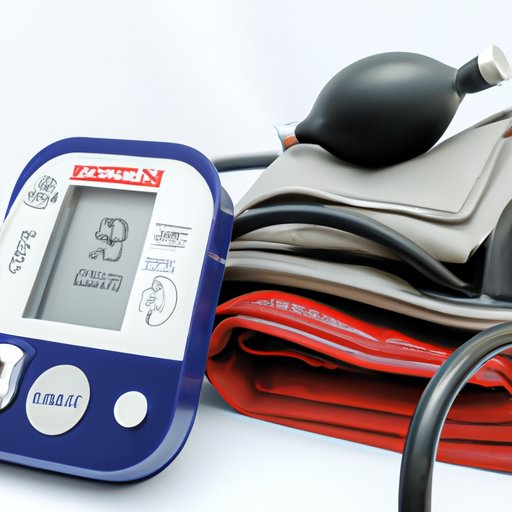
Introduction
Systolic blood pressure refers to the pressure in the arteries when the heart beats, and it is one of two readings used to determine blood pressure. High blood pressure, or hypertension, has been linked to serious health complications such as heart disease and stroke, making it crucial to keep systolic blood pressure under control. Fortunately, there are many strategies individuals can use to lower systolic blood pressure and reduce their risk of health complications.
Lifestyle changes
Lifestyle changes are often the first line of defense against high blood pressure. The following are some of the key steps individuals can take to lower their systolic blood pressure naturally:
Strategies for exercising regularly
Regular exercise can help lower blood pressure, and individuals are encouraged to aim for at least 30 minutes of moderate exercise most days of the week. Types of physical activity that are particularly effective for lowering blood pressure include brisk walking, jogging, biking, swimming, and dancing.
Tips on implementing a healthy diet
Eating a heart-healthy diet can significantly reduce systolic blood pressure. Individuals should aim to eat lots of fruits, vegetables, whole grains, lean protein, and healthy fats. Some specific foods that are particularly effective for lowering blood pressure include leafy greens, berries, fatty fish, and nuts.
How to reduce sodium intake
Reducing sodium intake can also help lower blood pressure. Individuals are encouraged to avoid processed and packaged foods, which often contain high levels of sodium. Instead, individuals should focus on cooking meals at home using fresh ingredients and spices to add flavor instead of salt.
The impact of limiting alcohol consumption
Drinking too much alcohol can contribute to high blood pressure. Experts generally recommend limiting alcohol to no more than one drink per day for women and two drinks per day for men.
Why quitting smoking can help
Smoking is a major risk factor for heart disease and can also contribute to high blood pressure. Quitting smoking can significantly reduce systolic blood pressure and the risk of heart disease.
Medications and supplements
In addition to lifestyle changes, there are a variety of medications and supplements that can help lower blood pressure. These options should be discussed with a medical professional:
Overview of different medications and supplements that can lower blood pressure
Some of the most common medications used to treat high blood pressure include diuretics, beta-blockers, ACE inhibitors, and calcium channel blockers. Additionally, supplements such as omega-3 fatty acids, magnesium, and potassium may also help reduce blood pressure.
Benefits and drawbacks to each option
Each medication or supplement has its unique benefits and drawbacks, and it is important to discuss options with a medical professional to determine which approach is right for each individual.
Possible side effects to consider
Some blood pressure medications and supplements may cause side effects, such as dizziness, fatigue, or upset stomach. Patients should be aware of common side effects when starting new medications or supplements.
The necessity of consulting with a medical professional
It is important to always consult with a medical professional before starting or stopping any medication or supplement.
Stress reduction techniques
Stress is a major contributor to high blood pressure, and reducing stress can help lower systolic blood pressure. Some effective stress reduction techniques include:
Tactics for reducing stress, such as meditation, deep breathing exercises, or yoga
These practices can help calm the body and reduce stress levels, which, over time, can help lower blood pressure.
How relaxation techniques can help lower blood pressure
Relaxation techniques help by reducing stress levels in the body, which can help lower blood pressure and reduce the risk of heart disease and stroke.
Monitoring blood pressure
Regularly monitoring blood pressure is essential for detecting high blood pressure and tracking progress in lowering it. There are a variety of strategies individuals can use to monitor their blood pressure:
The importance of monitoring blood pressure consistently
Consistent monitoring can help individuals understand how their systolic blood pressure changes in response to lifestyle changes and medications.
Explanation of how home blood pressure monitors work
Home blood pressure monitors work by measuring the pressure in the arteries using a cuff that is placed around the upper arm.
Recommendations for which monitors to use
It is important to use an accurate and reliable home blood pressure monitor. An individual’s healthcare provider can recommend a trustworthy brand.
Tips on how to track progress over time
Tracking systolic blood pressure over time can help individuals see how their lifestyle changes are impacting their blood pressure. It is important to consistently record blood pressure readings and bring this information to healthcare provider appointments.
Health complications
High systolic blood pressure can contribute to a variety of health complications. These potential risks make it crucial to make adjustments to one’s lifestyle and diet:
Explanation of potential risks of systolic blood pressure
High systolic blood pressure has been linked to heart disease, stroke, and kidney disease, among other complications.
How lifestyle factors can contribute to health complications
Unhealthy lifestyle habits such as not exercising, consuming too much alcohol or sodium, and smoking can all contribute to high systolic blood pressure and the associated risks.
Motivating readers to make adjustments to their lifestyles and diet
While the prospect of making lifestyle changes can be daunting, the potential health benefits are worth it. Lowering systolic blood pressure can reduce the risk of serious health complications and lead to a longer, healthier life.
Conclusion
Lowering systolic blood pressure is crucial for reducing the risk of heart disease, stroke, and other serious health complications. By making lifestyle changes, taking medications or supplements as prescribed by a medical professional, reducing stress levels, monitoring blood pressure, and adopting a healthy diet, individuals can significantly reduce their systolic blood pressure and improve their overall health. Remember that it is important to always consult with a healthcare provider before making any significant changes to one’s lifestyle or medication regimen.





